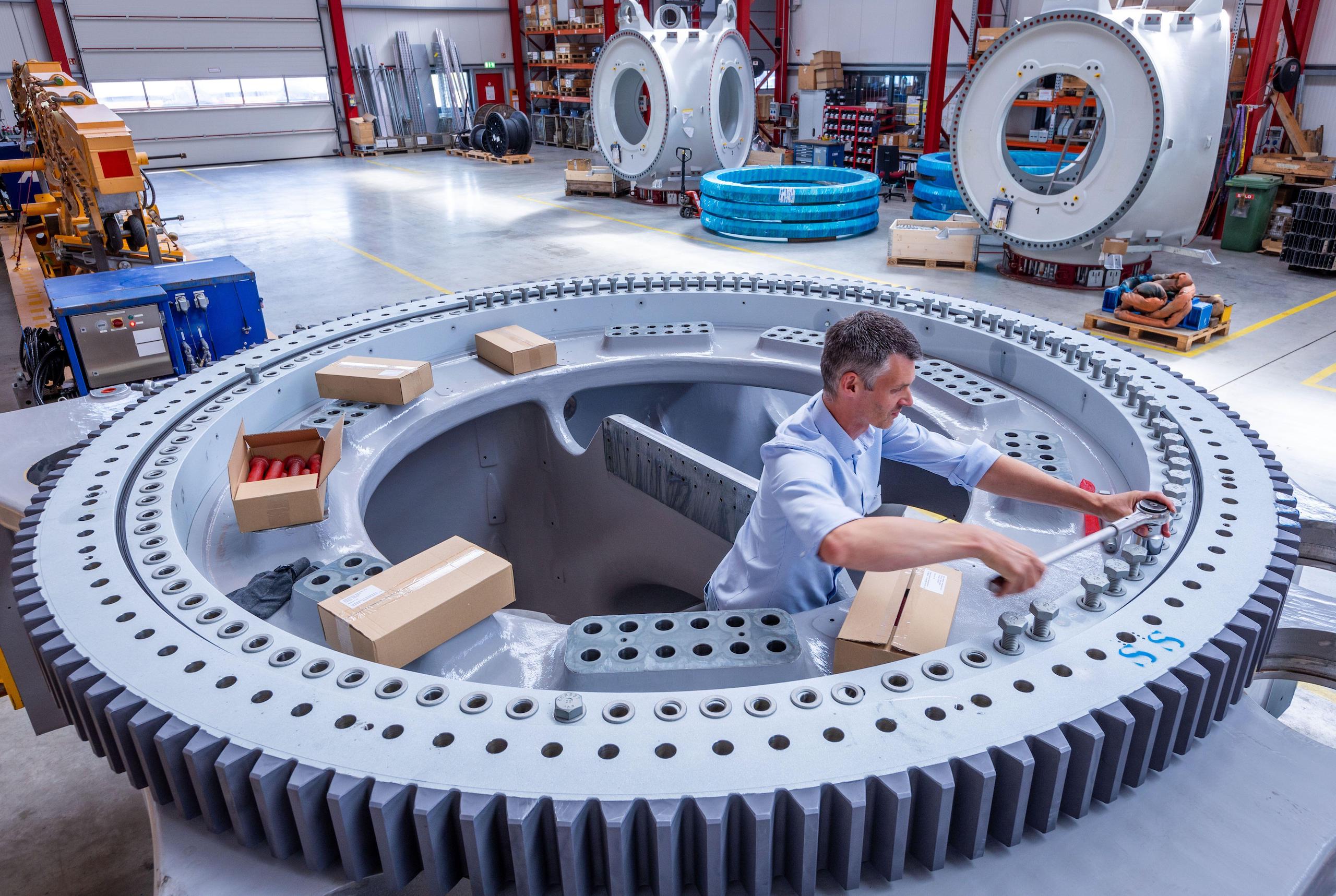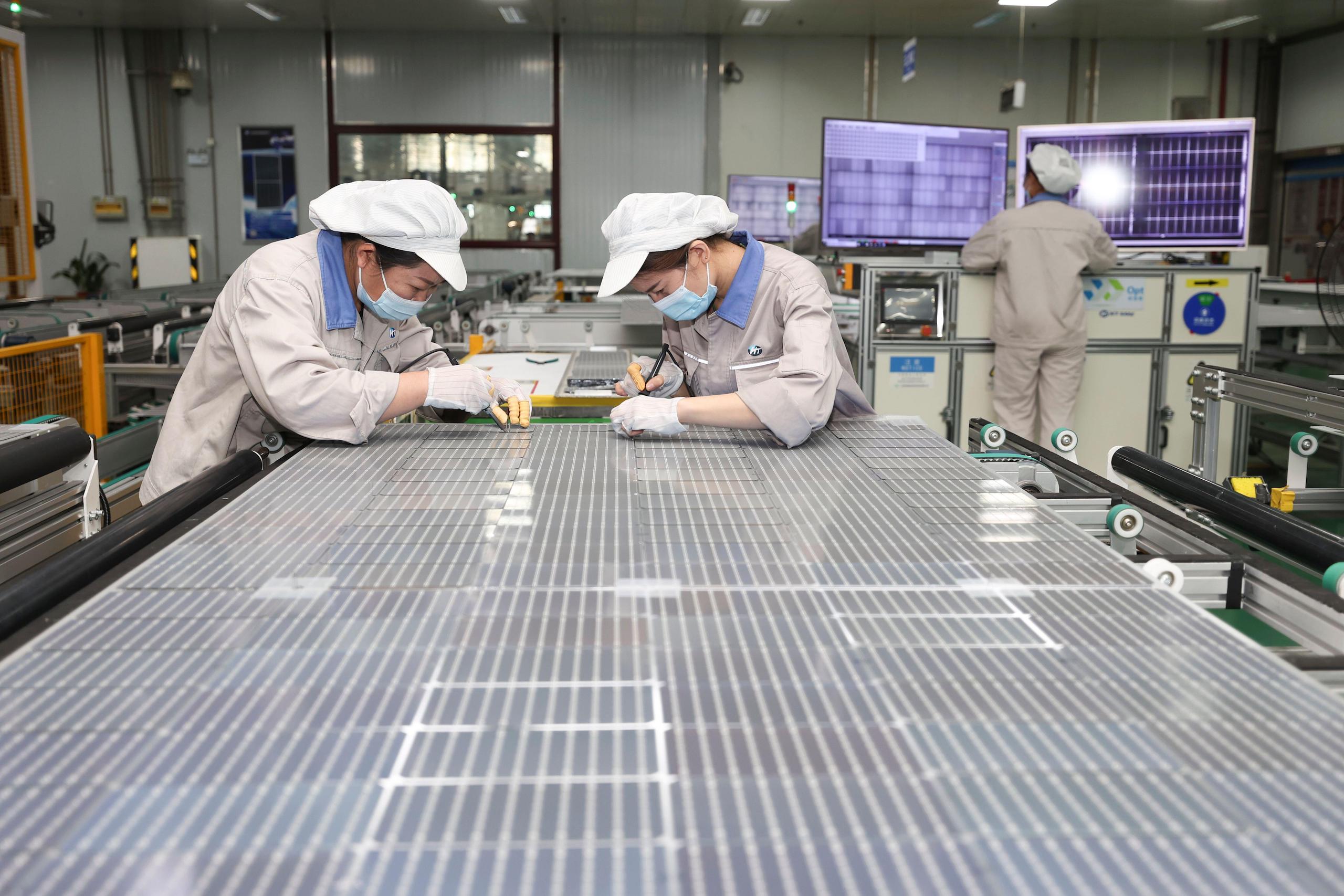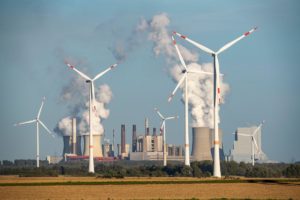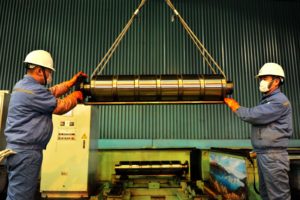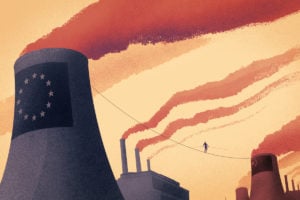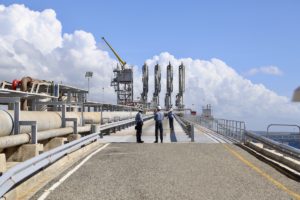A newly proposed European act aimed at boosting local manufacturing capacity of clean technologies is unlikely to directly impact Chinese companies, industry insiders have told China Dialogue.
The Net Zero Industry Act intends to strengthen the competitiveness of the European Union in technologies like wind turbines, solar panels, heat pumps and carbon capture and storage, by driving domestic production. It was put forward on 16 March by the European Commission, the EU’s primary executive body.
Sources in Chinese renewable firms told China Dialogue that it will be “very hard” for the EU to build complete manufacturing chains internally, especially if it wants to hit its renewable energy targets. They also said Chinese firms have sped up expanding into other overseas markets to mitigate the impact of possible EU and US restrictions.
European analysts agreed the act should not substantially impact Chinese firms, but gave different reasons. Some said its purpose is to provide a better policy environment for the EU’s clean tech industry, rather than to come “with all guns blazing”.
Others noted that even though the act sets a goal of at least 40% of Europe’s clean tech being locally produced by 2030, the language is “blurry”. One Belgium-based professor said the proposed act “in principle” shouldn’t affect Chinese companies because it does not require clean tech producers to source a certain amount of components from local suppliers.
Part of a wider green plan
The Net Zero Industry Act – alongside a Critical Raw Materials Act proposed on the same day – is part of a much broader plan called the Green Deal Industrial Plan.
The plan is widely considered the EU’s answer to the Inflation Reduction Act, which aims to boost US manufacturing capacity for clean tech through US$369 billion of subsidies. The US act, which was signed into law last August, sparked fears that companies would leave Europe to set up shop across the Atlantic.
But the Net Zero Industry Act differs from the subsidies-heavy American approach, in focussing on administrative support, such as cutting red tape for green industries.
This is because Europe is “inherently more complex”, and providing subsidies is not usually a measure EU-level policymakers can take, Domien Vangenechten, senior policy advisor at thinktank E3G, told China Dialogue. Besides, the EU has “a quite limited budget”.
Therefore, the European Commission is trying to “provide a space” for member states to come up with subsidies and tax incentives themselves, Vangenechten said.
A week before the act was proposed, the commission adopted a policy that loosened some rules on how EU member states could provide aid to companies.
According to Vangenechten, the Temporary Crisis and Transition Framework gives member states “the options to provide more support” for green technology manufacturing until the end of 2025.
He explained: “It introduces the possibility [for member states] to give tax breaks, for example. It also gives them the option to match subsidies” that projects could have been given by countries outside the EU.
But he pointed out that the framework contained “guardrails”. For example, member states have to prove subsidies will only make a project competitive, not “lead to windfall profits”.
According to law firm White & Case, states also have to demonstrate that foreign subsidies would otherwise cause a given project to leave the EU, and that their aid will not cause companies to relocate from one European country to another.
The relaxation of the state-aid rules amounted to the EU “stepping up its green subsidy race with the US” in the Guardian’s words.
How will the act work?
The cornerstones of the Net Zero Industry Act are eight net-zero technologies identified as “strategic”. These include solar, wind, batteries and carbon capture and storage; nuclear has not made the cut.
The act sets a headline benchmark for the strategic technologies. By 2030, EU manufacturing capacity for each should approach or reach “at least 40%” of the bloc’s annual deployment needs.
A series of actions are in the pipeline. For example, the act intends to reduce the administrative “burden” and simplify project permitting processes – issues that have restricted the growth of some industries in Europe, such as wind power.
“A lot of the permitting processes are done locally. They’re not necessarily super digitalised,” Pierre Tardieu, chief policy officer at WindEurope, a trade association, told China Dialogue. “Even though people want more wind, working through that red tape takes too much time.”
The act also requires public authorities to consider “sustainability and resilience” criteria – not just cost – while awarding contracts and ranking bids.
It will now go on to be discussed between the European Commission, the EU Parliament – the bloc’s law-making body – and the European Council, which comprises government ministers of each EU country.
Is European production realistic?
In 2021, China was the EU’s largest import partner for wind turbines and solar panels. The bloc is especially dependant on Chinese solar panels. Statistics from the EU show that it imported nearly €10 billion worth of solar panels in 2021, of which 89% came from China.
“Our dependency on Russian gas has taught us a number of lessons. Let’s not replace that dependency with a reliance on others to produce solar panels and other technologies we rely on,” Thierry Breton, European commissioner for internal market, said of the act.
But industry players in China see a Herculean task for the EU to grow home-based manufacturing chains, particularly given the pressure on the bloc to hit its climate and energy goals.
The EU aims to have “at least 32%” of its overall energy consumption supplied by renewables by 2030 and is looking to increase the portion to “at least 40%”. Overall, it plans to cut its greenhouse gas emissions by “at least 55%” by 2030, compared to 1990 levels.
A senior director at a Chinese solar panel firm told China Dialogue that they do not think the act will affect Chinese solar manufacturers “that much”.
One of the reasons is that renewable firms are motoring to secure markets in the rest of the world, such as the Middle East, Central Asia and Eastern Europe, in preparation for potential trade measures taken by the EU or the US.
China holds a market share of more than 80% in all key manufacturing stages of solar panels globally, according to the International Energy Agency.
The source, who agreed to speak on condition of anonymity, said it will be “very hard” for the EU to build a domestic manufacturing chain for solar panels from head to toe because of its current high reliance on Chinese firms and the high cost of production. “Even if they manage to build it, the final products will be really expensive,” they added.
Another reason is that the act was proposed to “prevent the European clean energy industry from moving to the US”, not to block Chinese companies, the source said.
Besides, the bloc “might not be able to hit its 2030 clean energy installation targets” if it wants to rely on domestic production at all stages.
The EU aims to bring online almost 600 gigawatts (GW) of solar photovoltaic power by 2030, more or less tripling its capacity compared to the end of 2022.
The source explained further that European companies might be able to localise some of the mid-to-downstream production for solar panels, such as cells and modules, but it would be difficult for them to develop upstream production.
They said, for example, the production of polysilicon, an upstream stage, requires a large amount of electricity, “but electricity in Europe is expensive”.
‘Further actions’ needed
The wind industry presents a different picture: 85% of EU demand is currently met by EU production, according to the European Commission.
But the figure could include some wind turbines produced in China for European firms.
Data from China’s Wind Energy Association show that more than two-thirds of the world’s wind turbines are manufactured in China, including those made for foreign brands. For example, more than half of the global orders by Vestas – the Danish wind turbine manufacturer owning the largest global market share in 2021 – are delivered by the company’s manufacturing bases in China, according to the Chinese association.
The EU will need 440 GW of wind energy by 2030, doubling the current capacity, to meet its emission reduction goal, according to Tardieu of WindEurope.
Gu Limin, a senior director at Envision Energy, a major Chinese wind turbine manufacture, said he expects the act to have “not much” impact on Chinese turbine manufacturers “for the time being” because the EU is not a “key” market for Chinese wind turbine firms for now.
But he pointed to the need for financial incentives for EU manufacturing to actually happen. “In the long term, it will need to depend on whether EU member states would take further actions to benefit local manufacturers, such as hefty subsidies,” Gu told China Dialogue. “Without that, it will be hard [for manufacturing] to return [to the EU].”
Views from China-focused analysts are similar. “Setting super ambitious targets is always the easy part,” Cosimo Ries, a renewable energy analyst at Beijing-based consultancy Trivium China, told China Dialogue.
“But whether the EU can actually succeed in building up entire supply chains and manufacturing capacity across so many industries at the same time… very much remains to be seen.”
Ries added that how the EU plans to respond to Chinese companies that want to open factories in the bloc “will be very interesting”.
Views from Europe
European experts interviewed by China Dialogue foresee the act having no major impact on Chinese firms. They also believe that Chinese companies should still be able to set up manufacturing bases in Europe in the future.
“We’ll probably welcome them with open arms,” said Berlin-based Vangenechten, of E3G.
However, experts have split opinions on the implications of the act’s proposed measures, especially its 40% benchmark.
Vangenechten described the percentage as the EU’s “aspirational goal” – not a requirement – to ensure the bloc’s access to these clean technologies in the event of global emergencies and geopolitical tensions.
Chinese companies are not going to lose access to the EU marketIgnacio Arroniz Velasco, researcher on trade and climate at E3G
He said that, in broad strokes, it refers to “all aspects of the production of these critical and strategical clean technologies”.
“This is a 40% target for, for example, how many windmills are installed in Europe, but [it’s] also about every little component, every magnet that gets produced that will go into that windmill,” Vangenechten said, adding that adjustments might well be made in a few years if one of the technologies is not on track to hit the benchmark.
Ignacio Arroniz Velasco, a researcher on trade and climate at E3G based in Brussels, interprets the act as a signal of action by the EU, rather than a threat to Chinese exports.
“Chinese companies are not going to lose access to the EU market. They’re not going to lose access to possibilities of selling their products to companies that install solar panels,” Arroniz said.
“The difference would be that there is now a clear signal that Europe is in the race for clean tech manufacturing as well, and that it will bring its own tools to the race.”
But some experts think the domestic production benchmark could be perceived as “trade-distortive subsidies”, which are prohibited by the World Trade Organization. Roberta Pierfederici at the London School of Economics (LSE) in the UK, not part of the EU, is one of them.
Pierfederici works as a policy analyst at the LSE’s Grantham Research Institute on Climate Change and the Environment. She said that like the Inflation Reduction Act, the Net Zero Industry Act “could play a powerful role” in driving the innovation of private sectors, but the prospect of government subsidies “could trigger global trade tensions”.
However, Pierfederici expected the EU–US subsidies competition to “accelerate the development and diffusion of green technologies in China as well as other countries” because it could foster innovation and generate “knowledge spill-overs”.
She also foresaw the potential for competition between the US, EU and China to drive down the cost of green technologies in the long run and, therefore, contribute to meeting global climate goals.
Other experts were more critical. The Brussels-based thinktank Bruegel voiced concern over “protectionism” after a draft of the act had been leaked before the final proposal was published.
Reinhilde Veugelers is a professor at KU Leuven in Belgium, and a senior fellow at Bruegel and the US-based Peterson Institute for International Economics.
Veugelers is “pretty disillusioned” by the proposed act because the text paints “a blurry picture”. She said the act, especially the 40% benchmark, leaves “a lot of unclarity”.
“Is it something they’re just going to monitor and see how far we get?” Veugelers asked. “Or if the target is not being met, would that lead to more support?” she added.
“What it definitely means for China is that the [EU] market is not closed. It just means that [products] need to be locally produced.”
Companies from China should still be able to open factories in the EU, Veugelers added. “In that respect, it’s not completely protectionist.”
